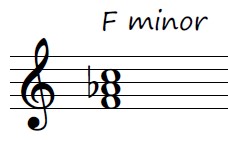Salford Piano Studio
Like interval inversions, chord inversions involve moving the bass note up an octave.
Since there are three notes in a triad, there are two possible inversions.
Root Position – 1st inversion – 2nd inversion
Let’s start with a C Major chord:
Using the C Major triad in our example:
Root position: the C is in the bass – C-E-G.
1st inversion: the E is in the bass – E-G-C
2nd inversion: the G is in the bass – G-C-E
The same rules apply to all Triads – Major, Minor, Augmented, and Diminished.
Let’s take an F Minor triad:
F–A♭ –C

Starting in the root position, we then have two inversions of the triad.
Root position: the F is in the bass – F-A♭-C
1st inversion: the A♭ is in the bass – A♭-C-F
2nd inversion: the C is in the bass – C-F-A♭
Example
Chopin’s famous Prelude in E Minor starts with a 1st inversion E Minor triad.
